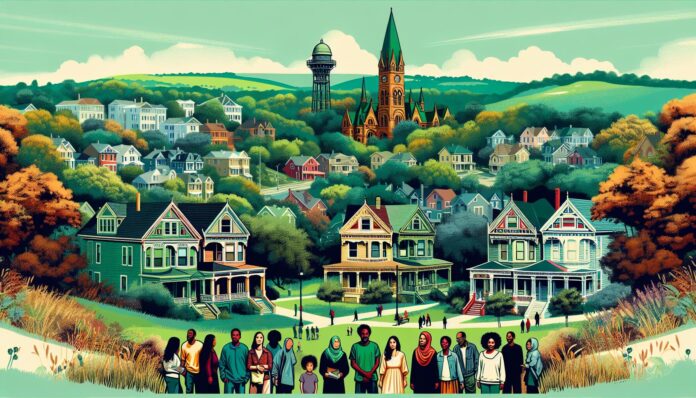I’ve always been fascinated by the stories that old buildings and streets whisper to those who walk by. That’s why I found myself drawn to the historic neighborhoods of Cincinnati, Ohio. Each one is like a time capsule, offering a glimpse into the past with its unique charm and character.
From the cobblestone streets of Over-the-Rhine to the grand Victorian homes in the Gaslight District, Cincinnati’s historic neighborhoods are a testament to the city’s rich history and diverse culture. I couldn’t wait to dive in and explore each one, uncovering the tales of yesteryear that echo through the architecture and the communities that have called these places home.
Over-the-Rhine: Cincinnati’s Historic Gem
When I first wandered through Over-the-Rhine (OTR), I was struck by the sheer beauty and resilience of its structures. This neighborhood, one of the largest historic districts in the United States, is a true testament to Cincinnati’s rich past. Walking down its streets, I felt like I had been transported to a different era, surrounded by stunning 19th-century architecture.
Over-the-Rhine is named after its founders, German immigrants who settled here in the mid-1800s. They likened crossing the Miami and Erie Canal to crossing the Rhine River in Germany, hence the name. What’s fascinating is how much of their influence remains visible today. From the ornate facades of the buildings to the cobblestone streets, there’s a sense of stepping into history that very few neighborhoods can offer.
Exploring OTR isn’t just about admiring its architecture; it’s about experiencing its vibrant community. The area has undergone a remarkable transformation in recent years, becoming a hub for arts, culture, and gastronomy. I found myself drawn to the Findlay Market, Ohio’s oldest continuously operated public market. Here, the air buzzes with the energy of local vendors selling everything from fresh produce to artisanal crafts. It’s a place where the past and present of Cincinnati converge, creating a lively and welcoming atmosphere.
But what truly sets OTR apart for me are the stories. Each building, each street corner, seems to hold secrets waiting to be discovered. I spent an afternoon at the historic Music Hall, a venue that has seen performances from symphonies to rock bands since 1878. Standing in the grand foyer, I couldn’t help but feel the echoes of the past, of all the artists and audiences who have shared moments of joy and sorrow within its walls.
As I continued my journey through Over-the-Rhine, I dove deeper into its cultural scene. The neighborhood boasts an impressive array of street art, with murals that reflect its diverse history and community. These pieces do more than beautify the area; they tell its stories in vibrant colors, making art accessible to all who wander through OTR.
The Gaslight District: Victorian Elegance
As I wandered away from the bustling streets of Over-the-Rhine, I found myself stepping into a different era in the Gaslight District. Known for its leafy streets and Victorian-era homes, this neighborhood carries a charm that’s both enchanting and timeless. It’s like walking onto a movie set where every corner tells a story of elegance and historical depth.
The streets here are lined with gas lamps, an homage to the past that gives the district its name. At dusk, these lamps cast a soft, golden glow, enhancing the neighborhood’s allure. It’s not just the gas lamps that catch the eye, though. The Victorian architecture is absolutely mesmerizing. With intricate woodwork, towering spires, and stained glass windows, these homes transport you to a bygone era. It’s easy to spend hours simply walking around, admiring the craftsmanship and imagining the lives of those who first called these streets home.
But the Gaslight District isn’t stuck in the past. Modern cafes, boutiques, and art galleries nestle comfortably among the historical homes, offering a vibrant contemporary lifestyle. I found myself drawn to a cozy bookstore that seemed to hold tales not just within its books but within its very walls. The blend of old and new here is seamless, creating a living, breathing tapestry of Cincinnati’s history and progress.
One can’t talk about the Gaslight District without mentioning the Clifton Cultural Arts Center. Housed in a stunning historic building, this center is a beacon of art and culture, hosting exhibitions, classes, and events that bring the community together. It’s a place where history meets creativity, adding yet another layer to the district’s rich tapestry.
My visit to the Gaslight District was a reminder of the power of preservation and progress. By honoring its past while embracing the future, this neighborhood stands as a testament to Cincinnati’s ever-evolving identity. Whether you’re a history buff, an architecture enthusiast, or simply someone who appreciates beauty, the Gaslight District has something for everyone.
Mount Adams: A Picturesque Retreat
Tucked away to the east of Cincinnati’s bustling city center, I found Mount Adams, a quaint and picturesque neighborhood that immediately captured my heart. With its narrow, winding streets and stunning views of the Ohio River and downtown Cincinnati, Mount Adams feels like a world apart. It’s a place where history and modernity intertwine in the most enchanting way.
The charm of Mount Adams is undeniable. As I strolled through the area, the blend of architectural styles, from Victorian to contemporary, spoke volumes about the neighborhood’s rich past and vibrant present. The Holy Cross-Immaculata Church, a prominent landmark, stands guard over the district, its majestic presence a reminder of the community’s deep roots.
Dining in Mount Adams is an experience in itself. The neighborhood boasts a variety of eateries that cater to every palate. Whether you’re in the mood for a gourmet meal or just a cozy spot to sip on some coffee, you’ll find it here. The Rookwood Pottery Company, not just a restaurant but also a piece of Cincinnati’s history, offers a unique dining experience amidst the kilns and pottery pieces that hark back to the city’s industrious past.
But Mount Adams isn’t just about appreciating the past. The area thrives with contemporary life. Art lovers will revel in the Cincinnati Art Museum and the Krohn Conservatory, both of which are nestled within Eden Park. These institutions not only offer a deep dive into artistic and botanical wonders but also provide lush green spaces that are perfect for picnics or leisurely walks.
For those who love the nightlife, Mount Adams does not disappoint. The neighborhood comes alive at night, with bars and clubs offering live music, cocktails, and stunning city views. It’s a vibrant atmosphere that attracts a diverse crowd, from locals to tourists looking to experience Cincinnati’s lively side.
Mount Adams has this unique ability to make everyone feel at home, whether you’re a history buff, an art enthusiast, or simply someone seeking a picturesque retreat from the hustle and bustle of city life. Its winding streets lead to unexpected discoveries, and its panoramic views remind me why I fell in love with Cincinnati in the first place.
Walnut Hills: Historic Architecture and Culture
As I continued my journey through Cincinnati’s historic neighborhoods, Walnut Hills caught my attention next. Known for its rich history and diverse culture, this neighborhood offers a fascinating blend of architecture and community life that’s absolutely captivating.
Walnut Hills’ architecture is a real treat for history buffs like me. Strolling down the streets, you’re greeted by an array of styles ranging from Victorian to modernist landmarks. One cannot help but be impressed by the Harriet Beecher Stowe House, where the author of “Uncle Tom’s Cabin” lived and wrote part of this pivotal novel. This house stands as a testament to the neighborhood’s involvement in the Underground Railroad, highlighting its role in the fight for freedom and justice.
Another iconic structure that deserves mention is the Eden Park Standpipe. This quirky, castle-like structure isn’t just a piece of unique architecture; it symbolizes the innovation of Cincinnati’s water system in the late 19th century. Eden Park, which surrounds the standpipe, further emphasizes the area’s natural beauty alongside its historical significance.
Culturally, Walnut Hills is a melting pot, offering an array of experiences that reflect its diverse community. The neighborhood is home to several cultural institutions, including the Cincinnati Art Museum and the Playhouse in the Park, positioning it as a haven for art lovers.
For those who appreciate the culinary arts, Walnut Hills does not disappoint. It boasts a variety of dining options, from cozy cafés to exquisite restaurants, each offering flavors that represent the neighborhood’s eclectic community. The local cuisine here is a reflection of the area’s history and cultural diversity, making dining out in Walnut Hills an experience in itself.
| Place | Interest |
|---|---|
| Harriet Beecher Stowe House | Historical significance |
| Eden Park Standpipe | Architectural curiosity |
| Cincinnati Art Museum | Cultural Institution |
| Playhouse in the Park | Cultural Institution |
Each visit to Walnut Hills promises new discoveries and insights, further cementing its status as a significant historic and cultural hub in Cincinnati. As I wander through its streets, I’m constantly reminded of the layers of history and culture that make up this vibrant neighborhood, offering a unique glimpse into the past while very much alive in the present.
Conclusion
Exploring Walnut Hills has been an eye-opening journey for me. I’ve been captivated by the blend of history and culture that pulses through the streets. It’s not just about the buildings or the landmarks; it’s the stories they tell and the community that thrives among them. Every corner turned offers a new piece of history or a unique cultural experience. I’ve come to see Walnut Hills as more than a neighborhood; it’s a living museum where every visit enriches my understanding of Cincinnati’s diverse heritage. I’m already looking forward to my next adventure here, eager to uncover more of what makes this place so special.



![Top Kid-Friendly Eats & Fun in [Specific Neighborhood] Cincinnati](https://queencitybuzz.com/wp-content/uploads/2024/03/80M4yIoZGkTTPpLZlG9GQ-218x150.jpg)













